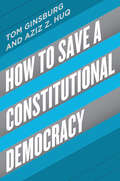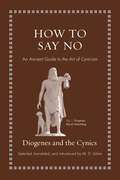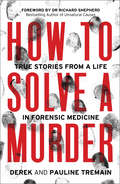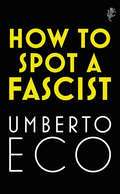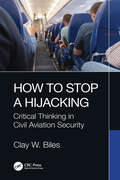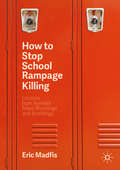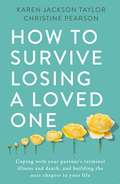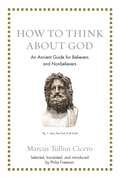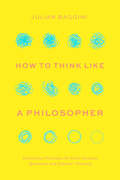- Table View
- List View
How to Resolve Conflict in Organizations: The Power of People Models and Procedure
by Annamaria GardenThis is a comprehensive guide using People Models to understand and resolve conflict at different levels of the organization. It starts at the inter-organizational level explaining conflict between organizations that are involved in mergers and acquisitions. It looks at this kind of conflict not from the point of view of a business and economic rationale but from the point of view of there being a relationship between the two organizations. Here, this relationship is described by a People Model which outlines three different relationship types. In the subsequent chapters we look at the organizational level; first at structural conflict and then at team conflict. In each chapter there is a People Model to explain and resolve conflict. Structural conflict is explained by the Myers Briggs Type Indicator (MBTI) and team conflict is explained by the Schutz model of Inclusion, Control and Openness. In the next chapter the conflict is explained in terms of Gestalt psychology and looks at interpersonal conflict. Carl Jung is then used to explore inner conflict; followed by a chapter on life conflict exploring conflict in terms of how you live a life. The final chapter is focused on the applications of the People Models analysing Donald Trump and Tony Blair. Following through the entire book is a step-by-step procedure called a People Procedure, which is contrasted with a Business Procedure. The former guides you through a process to unravel and resolve conflict.
How to Resolve Conflict in Organizations: The Power of People Models and Procedure
by Annamaria GardenThis is a comprehensive guide using People Models to understand and resolve conflict at different levels of the organization. It starts at the inter-organizational level explaining conflict between organizations that are involved in mergers and acquisitions. It looks at this kind of conflict not from the point of view of a business and economic rationale but from the point of view of there being a relationship between the two organizations. Here, this relationship is described by a People Model which outlines three different relationship types. In the subsequent chapters we look at the organizational level; first at structural conflict and then at team conflict. In each chapter there is a People Model to explain and resolve conflict. Structural conflict is explained by the Myers Briggs Type Indicator (MBTI) and team conflict is explained by the Schutz model of Inclusion, Control and Openness. In the next chapter the conflict is explained in terms of Gestalt psychology and looks at interpersonal conflict. Carl Jung is then used to explore inner conflict; followed by a chapter on life conflict exploring conflict in terms of how you live a life. The final chapter is focused on the applications of the People Models analysing Donald Trump and Tony Blair. Following through the entire book is a step-by-step procedure called a People Procedure, which is contrasted with a Business Procedure. The former guides you through a process to unravel and resolve conflict.
How to Save a Constitutional Democracy
by Tom Ginsburg Aziz Z. HuqDemocracies are in danger. Around the world, a rising wave of populist leaders threatens to erode the core structures of democratic self-rule. In the United States, the tenure of Donald Trump has seemed decisive turning point for many. What kind of president intimidates jurors, calls the news media the “enemy of the American people,” and seeks foreign assistance investigating domestic political rivals? Whatever one thinks of President Trump, many think the Constitution will safeguard us from lasting damage. But is that assumption justified? How to Save a Constitutional Democracy mounts an urgent argument that we can no longer afford to be complacent. Drawing on a rich array of other countries’ experiences with democratic backsliding, Tom Ginsburg and Aziz Z. Huq show how constitutional rules can both hinder and hasten the decline of democratic institutions. The checks and balances of the federal government, a robust civil society and media, and individual rights—such as those enshrined in the First Amendment—often fail as bulwarks against democratic decline. The sobering reality for the United States, Ginsburg and Huq contend, is that the Constitution’s design makes democratic erosion more, not less, likely. Its structural rigidity has had unforeseen consequence—leaving the presidency weakly regulated and empowering the Supreme Court conjure up doctrines that ultimately facilitate rather than inhibit rights violations. Even the bright spots in the Constitution—the First Amendment, for example—may have perverse consequences in the hands of a deft communicator who can degrade the public sphere by wielding hateful language banned in many other democracies. We—and the rest of the world—can do better. The authors conclude by laying out practical steps for how laws and constitutional design can play a more positive role in managing the risk of democratic decline.
How to Save a Constitutional Democracy
by Tom Ginsburg Aziz Z. HuqDemocracies are in danger. Around the world, a rising wave of populist leaders threatens to erode the core structures of democratic self-rule. In the United States, the tenure of Donald Trump has seemed decisive turning point for many. What kind of president intimidates jurors, calls the news media the “enemy of the American people,” and seeks foreign assistance investigating domestic political rivals? Whatever one thinks of President Trump, many think the Constitution will safeguard us from lasting damage. But is that assumption justified? How to Save a Constitutional Democracy mounts an urgent argument that we can no longer afford to be complacent. Drawing on a rich array of other countries’ experiences with democratic backsliding, Tom Ginsburg and Aziz Z. Huq show how constitutional rules can both hinder and hasten the decline of democratic institutions. The checks and balances of the federal government, a robust civil society and media, and individual rights—such as those enshrined in the First Amendment—often fail as bulwarks against democratic decline. The sobering reality for the United States, Ginsburg and Huq contend, is that the Constitution’s design makes democratic erosion more, not less, likely. Its structural rigidity has had unforeseen consequence—leaving the presidency weakly regulated and empowering the Supreme Court conjure up doctrines that ultimately facilitate rather than inhibit rights violations. Even the bright spots in the Constitution—the First Amendment, for example—may have perverse consequences in the hands of a deft communicator who can degrade the public sphere by wielding hateful language banned in many other democracies. We—and the rest of the world—can do better. The authors conclude by laying out practical steps for how laws and constitutional design can play a more positive role in managing the risk of democratic decline.
How to Save a Constitutional Democracy
by Tom Ginsburg Aziz Z. HuqDemocracies are in danger. Around the world, a rising wave of populist leaders threatens to erode the core structures of democratic self-rule. In the United States, the tenure of Donald Trump has seemed decisive turning point for many. What kind of president intimidates jurors, calls the news media the “enemy of the American people,” and seeks foreign assistance investigating domestic political rivals? Whatever one thinks of President Trump, many think the Constitution will safeguard us from lasting damage. But is that assumption justified? How to Save a Constitutional Democracy mounts an urgent argument that we can no longer afford to be complacent. Drawing on a rich array of other countries’ experiences with democratic backsliding, Tom Ginsburg and Aziz Z. Huq show how constitutional rules can both hinder and hasten the decline of democratic institutions. The checks and balances of the federal government, a robust civil society and media, and individual rights—such as those enshrined in the First Amendment—often fail as bulwarks against democratic decline. The sobering reality for the United States, Ginsburg and Huq contend, is that the Constitution’s design makes democratic erosion more, not less, likely. Its structural rigidity has had unforeseen consequence—leaving the presidency weakly regulated and empowering the Supreme Court conjure up doctrines that ultimately facilitate rather than inhibit rights violations. Even the bright spots in the Constitution—the First Amendment, for example—may have perverse consequences in the hands of a deft communicator who can degrade the public sphere by wielding hateful language banned in many other democracies. We—and the rest of the world—can do better. The authors conclude by laying out practical steps for how laws and constitutional design can play a more positive role in managing the risk of democratic decline.
How to Save a Constitutional Democracy
by Tom Ginsburg Aziz Z. HuqDemocracies are in danger. Around the world, a rising wave of populist leaders threatens to erode the core structures of democratic self-rule. In the United States, the tenure of Donald Trump has seemed decisive turning point for many. What kind of president intimidates jurors, calls the news media the “enemy of the American people,” and seeks foreign assistance investigating domestic political rivals? Whatever one thinks of President Trump, many think the Constitution will safeguard us from lasting damage. But is that assumption justified? How to Save a Constitutional Democracy mounts an urgent argument that we can no longer afford to be complacent. Drawing on a rich array of other countries’ experiences with democratic backsliding, Tom Ginsburg and Aziz Z. Huq show how constitutional rules can both hinder and hasten the decline of democratic institutions. The checks and balances of the federal government, a robust civil society and media, and individual rights—such as those enshrined in the First Amendment—often fail as bulwarks against democratic decline. The sobering reality for the United States, Ginsburg and Huq contend, is that the Constitution’s design makes democratic erosion more, not less, likely. Its structural rigidity has had unforeseen consequence—leaving the presidency weakly regulated and empowering the Supreme Court conjure up doctrines that ultimately facilitate rather than inhibit rights violations. Even the bright spots in the Constitution—the First Amendment, for example—may have perverse consequences in the hands of a deft communicator who can degrade the public sphere by wielding hateful language banned in many other democracies. We—and the rest of the world—can do better. The authors conclude by laying out practical steps for how laws and constitutional design can play a more positive role in managing the risk of democratic decline.
How to Save a Constitutional Democracy
by Tom Ginsburg Aziz Z. HuqDemocracies are in danger. Around the world, a rising wave of populist leaders threatens to erode the core structures of democratic self-rule. In the United States, the tenure of Donald Trump has seemed decisive turning point for many. What kind of president intimidates jurors, calls the news media the “enemy of the American people,” and seeks foreign assistance investigating domestic political rivals? Whatever one thinks of President Trump, many think the Constitution will safeguard us from lasting damage. But is that assumption justified? How to Save a Constitutional Democracy mounts an urgent argument that we can no longer afford to be complacent. Drawing on a rich array of other countries’ experiences with democratic backsliding, Tom Ginsburg and Aziz Z. Huq show how constitutional rules can both hinder and hasten the decline of democratic institutions. The checks and balances of the federal government, a robust civil society and media, and individual rights—such as those enshrined in the First Amendment—often fail as bulwarks against democratic decline. The sobering reality for the United States, Ginsburg and Huq contend, is that the Constitution’s design makes democratic erosion more, not less, likely. Its structural rigidity has had unforeseen consequence—leaving the presidency weakly regulated and empowering the Supreme Court conjure up doctrines that ultimately facilitate rather than inhibit rights violations. Even the bright spots in the Constitution—the First Amendment, for example—may have perverse consequences in the hands of a deft communicator who can degrade the public sphere by wielding hateful language banned in many other democracies. We—and the rest of the world—can do better. The authors conclude by laying out practical steps for how laws and constitutional design can play a more positive role in managing the risk of democratic decline.
How to Save a Constitutional Democracy
by Tom Ginsburg Aziz Z. HuqDemocracies are in danger. Around the world, a rising wave of populist leaders threatens to erode the core structures of democratic self-rule. In the United States, the tenure of Donald Trump has seemed decisive turning point for many. What kind of president intimidates jurors, calls the news media the “enemy of the American people,” and seeks foreign assistance investigating domestic political rivals? Whatever one thinks of President Trump, many think the Constitution will safeguard us from lasting damage. But is that assumption justified? How to Save a Constitutional Democracy mounts an urgent argument that we can no longer afford to be complacent. Drawing on a rich array of other countries’ experiences with democratic backsliding, Tom Ginsburg and Aziz Z. Huq show how constitutional rules can both hinder and hasten the decline of democratic institutions. The checks and balances of the federal government, a robust civil society and media, and individual rights—such as those enshrined in the First Amendment—often fail as bulwarks against democratic decline. The sobering reality for the United States, Ginsburg and Huq contend, is that the Constitution’s design makes democratic erosion more, not less, likely. Its structural rigidity has had unforeseen consequence—leaving the presidency weakly regulated and empowering the Supreme Court conjure up doctrines that ultimately facilitate rather than inhibit rights violations. Even the bright spots in the Constitution—the First Amendment, for example—may have perverse consequences in the hands of a deft communicator who can degrade the public sphere by wielding hateful language banned in many other democracies. We—and the rest of the world—can do better. The authors conclude by laying out practical steps for how laws and constitutional design can play a more positive role in managing the risk of democratic decline.
How to Say No: An Ancient Guide to the Art of Cynicism (Ancient Wisdom for Modern Readers)
by DiogenesAn entertaining and enlightening collection of ancient writings about the philosophers who advocated simple living and rejected unthinking conformityThe Cynics were ancient Greek philosophers who stood athwart the flood of society’s material excess, unexamined conventions, and even norms of politeness and thundered “No!” Diogenes, the most famous Cynic, wasn’t shy about literally extending his middle finger to the world, expressing mock surprise that “most people go crazy over a finger.” When asked why he was called Diogenes the Dog, he replied “because I fawn on those who give, I bark at those who don’t, and I bite scoundrels.” How to Say No is a delightful collection of brief ancient writings about Cynicism that captures all the outrageousness, wit, and wisdom of its remarkable cast of characters—from Diogenes in the fourth century BCE to the column-stander Symeon Stylites in late antiquity.With their “less is more” approach to life, the Cynics speak urgently to our world of climate change, economic uncertainty, and psychic malaise. Although the Cynics weren’t writers, their memorable utterances and behavior were recorded by their admirers and detractors, and M. D. Usher offers fresh new translations of appealing selections from this body of writing—ranging from street sermons and repartee to biography and snapshots of Cynics in action.Complete with introductions to the volume and each selection as well as the original Greek and Latin on facing pages, this lively book demonstrates why the Cynics still retain their power to surprise us and make us laugh—and to make us think and question how we live.
How to Say No: An Ancient Guide to the Art of Cynicism (Ancient Wisdom for Modern Readers)
by DiogenesAn entertaining and enlightening collection of ancient writings about the philosophers who advocated simple living and rejected unthinking conformityThe Cynics were ancient Greek philosophers who stood athwart the flood of society’s material excess, unexamined conventions, and even norms of politeness and thundered “No!” Diogenes, the most famous Cynic, wasn’t shy about literally extending his middle finger to the world, expressing mock surprise that “most people go crazy over a finger.” When asked why he was called Diogenes the Dog, he replied “because I fawn on those who give, I bark at those who don’t, and I bite scoundrels.” How to Say No is a delightful collection of brief ancient writings about Cynicism that captures all the outrageousness, wit, and wisdom of its remarkable cast of characters—from Diogenes in the fourth century BCE to the column-stander Symeon Stylites in late antiquity.With their “less is more” approach to life, the Cynics speak urgently to our world of climate change, economic uncertainty, and psychic malaise. Although the Cynics weren’t writers, their memorable utterances and behavior were recorded by their admirers and detractors, and M. D. Usher offers fresh new translations of appealing selections from this body of writing—ranging from street sermons and repartee to biography and snapshots of Cynics in action.Complete with introductions to the volume and each selection as well as the original Greek and Latin on facing pages, this lively book demonstrates why the Cynics still retain their power to surprise us and make us laugh—and to make us think and question how we live.
How to Set up and Run a Law Clinic: Principles and Practice (How To Guides)
by Donald Nicolson JoNel Newman Richard GrimesThis accessible How To Guide provides practical, expert guidance on how to successfully set up and run a law clinic. Donald Nicolson, JoNel Newman and Richard Grimes explore the process of designing a clinic to address unmet legal needs, enhance student learning, and maximise the additional benefits of a clinic. How to Set up and Run a Law Clinic is a comprehensive guide to the theory and practice of running a clinic. Based on the authors’ first-hand experience, the book analyses a variety of day-to-day issues that can arise when setting up a law clinic and provides invaluable solutions to these commonly occurring challenges. In investigating how clinics may be run, and what services they can provide, the book investigates possible tensions between educational and social justice objectives, and how they may be resolved to meet these dual aims. The book examines how the expectations of all stakeholders, including those with regulatory oversight of clinical activities, can be managed and met.Those working within law schools who are wishing to set up or expand law clinics will find this book to be highly useful. It will be a valuable resource for those aiming to enhance employability and experiential learning offerings. Students, and legal practitioners, wishing to gain insight into the value of clinical work will also find this to be a helpful guide.
How to Solve a Crime: Stories from the Cutting Edge of Forensics
by Professor Angela GallopPre-order now: The gripping new book by the UK's most eminent forensic scientists, Angela Gallop__________CRIME [Noun]: An action or omission which constitutes an offence and is punishable by lawForensic science is one of the most important aspects of any criminal investigation.The impartial and objective evidence it provides can help convict the innocent and incarcerate the guilty. It enables courts to have the confidence in their decisions and to ensure that justice is done. Professor Angela Gallop has been at the forefront of forensics for more than 45 years. During her remarkable career, she has established and run forensic science laboratories and has worked on thousands of cases in the UK and across the world. In How to Solve a Crime, she describes some of her own and her colleagues most intriguing cases and the wide range of skills and techniques used to solve them. Whether it's looking at blood patterns and footwear marks at crime scenes to work out what happened, extracting data from suspects mobile phones to discover where they were at critical times, or analysing fragments of textiles fibers, glass or paint to determine where they might have come from, Gallop shows that every contact really does leave a trace and every trace can help to solve a crime. With unparalleled access and insight across a wide range of specialisms, How to Solve a Crime is a fascinating definitive and authoritative account of real-life forensic science. _________Praise for WHEN THE DOGS DON'T BARK'Fascinating' Guardian 'Offers a chilling glimpse into her life's work. . . fascinating stuff' Sunday Times 'Compelling' Daily Mirror 'A casebook that reads like The Encyclopaedia of Murder' Daily Express 'One of the professions leading lights' Woman & Home
How to Solve a Murder: True Stories From A Life In Forensic Medicine
by Derek Tremain Pauline TremainAs gripping as it is gruesome, How to Solve a Murder is a fascinating insight into the career of a forensic scientist told by experts in the field. Includes a foreword from Dr Richard Shepherd, bestselling author of Unnatural Causes.
How to Spot a Fascist
by Umberto EcoWe are here to remember what happened and to declare solemnly that ‘they’ must never do it again. But who are ‘they’?HOW TO SPOT A FASCIST is a selection of three thought-provoking essays on freedom and fascism, censorship and tolerance – including Eco’s iconic essay ‘Ur-Fascism’, which lists the fourteen essential characteristics of fascism, and draws on his own personal experiences growing up in the shadow of Mussolini. Umberto Eco remains one of the greatest writers and cultural commentators of the last century. In these pertinent pieces, he warns against prejudice and abuses of power and proves a wise and insightful guide for our times. If we strive to learn from our collective history and come together in challenging times, we can hope for a peaceful and tolerant future. Freedom and liberation are never-ending tasks. Let this be our motto: ‘Do not forget.’
How to Steal a Presidential Election
by Lawrence Lessig Matthew SeligmanFrom two distinguished experts on election law, an alarming look at how the American presidency could be stolen—by entirely legal means Even in the fast and loose world of the Trump White House, the idea that a couple thousand disorganized protestors storming the U.S. Capitol might actually prevent a presidential succession was farfetched. Yet perfectly legal ways of overturning election results actually do exist, and they would allow a political party to install its own candidate in place of the true winner. Lawrence Lessig and Matthew Seligman work through every option available for subverting a presumptively legitimate result—from vice-presidential intervention to election decertification and beyond. While many strategies would never pass constitutional muster, Lessig and Seligman explain how some might. They expose correctable weaknesses in the system, including one that could be corrected only by the Supreme Court. Any strategy aimed at hacking a presidential election is a threat to democracy. This book is a clarion call to shore up the insecure system for electing the president before American democracy is forever compromised.
How to Stop a Hijacking: Critical Thinking in Civil Aviation Security
by Clay W. BilesHijackings and bombings have plagued civil aviation since 1930 and air rage incidents are on the rise. While there is aircraft and inflight training available for air marshals, other first responders receive minimal training on inflight security awareness and protocols. There are no other resources currently available to flight crews or armed first responders that specifically address inflight security and how to address threats of disturbances on airplanes.How to Stop a Hijacking provides readers with fundamental principles on how to think more critically about onboard security threats. The aircraft cabin poses unique environment and security challenges, and first responders can apply security awareness and critical thinking skills to establish a safer environment in the cabin and airport for everyone onboard. The lessons in this book are driven with the central objective of teaching the reader how to counter inflight aggression and maintain tactical control of the cabin. Written by a former federal air marshal instructor, this book looks at the recent rash of air rage incidents and violence on airplanes, in addition to the real and ever-present threat of hijack or potential explosive device.How to Stop a Hijacking is a practical guide that offers methodological and tactically proven strategies for stopping violent acts onboard an aircraft inflight.
How to Stop a Hijacking: Critical Thinking in Civil Aviation Security
by Clay W. BilesHijackings and bombings have plagued civil aviation since 1930 and air rage incidents are on the rise. While there is aircraft and inflight training available for air marshals, other first responders receive minimal training on inflight security awareness and protocols. There are no other resources currently available to flight crews or armed first responders that specifically address inflight security and how to address threats of disturbances on airplanes.How to Stop a Hijacking provides readers with fundamental principles on how to think more critically about onboard security threats. The aircraft cabin poses unique environment and security challenges, and first responders can apply security awareness and critical thinking skills to establish a safer environment in the cabin and airport for everyone onboard. The lessons in this book are driven with the central objective of teaching the reader how to counter inflight aggression and maintain tactical control of the cabin. Written by a former federal air marshal instructor, this book looks at the recent rash of air rage incidents and violence on airplanes, in addition to the real and ever-present threat of hijack or potential explosive device.How to Stop a Hijacking is a practical guide that offers methodological and tactically proven strategies for stopping violent acts onboard an aircraft inflight.
How to Stop School Rampage Killing: Lessons from Averted Mass Shootings and Bombings
by Eric MadfisThis book tackles the important question of how we can understand and learn from the school rampage killings that have been prevented. In the flood of recent accounts and analyses of deadly school rampage killings that plague society and inspire widespread public fear, very little attention has been given to the incidents that almost were. Building on Madfis’ previous book, The Risk of School Rampage: Assessing and Preventing Threats of School Violence (2014), this vital work addresses key gaps in school violence scholarship through the examination of averted school rampage incidents in the United States and advances existing knowledge through ground-breaking insights from the latest research on mass murder, violence prevention, bystander intervention, disciplinary policy, and threat assessment in school contexts. This empirical study utilizes in-depth interviews conducted with school and police officials (administrators, counselors, security guards, police officers, and teachers) directly involved in averting potential school rampages to explore the processes by which threats are assessed and school rampage plots are thwarted. Madfis finds that many common contemporary school violence prevention policies and practices are ineffective at preventing rampage attacks and may actually increase the likelihood of their occurrence. Rather than uncritically adopting such problematic approaches, Madfis argues that schools must model prevention practices upon what has proven successful in averting potentially deadly incidents.
How to Survive a Medical Malpractice Lawsuit: The Physician's Roadmap for Success (How - How To Ser. #23)
by Ilene R. BrennerEveryone seeks to avoid getting into a lawsuit, but what do you do if this does happen? Getting sued for medical malpractice is one of the most traumatic events of a physician's career. This text will guide doctors and physicians through the process from the moment they receive a summons until the after-trial appeal process. Containing valuable information that physicians need to know to prevent making critical mistakes that can hurt their case With strategies explained to maximize their chances of a defendant's verdict. Including vital information on how to change your attorney, act at the deposition and dress for court, Navigating through what is a mysterious and terrifying process in non-legalese language that is easy to understand including what makes patients angry, strategies for coping, sample questions and tips on answering them to what happens in court and how to continue if there is a bad outcome.
How to Survive a Medical Malpractice Lawsuit: The Physician's Roadmap for Success (How To #17)
by Ilene R. BrennerEveryone seeks to avoid getting into a lawsuit, but what do you do if this does happen? Getting sued for medical malpractice is one of the most traumatic events of a physician's career. This text will guide doctors and physicians through the process from the moment they receive a summons until the after-trial appeal process. Containing valuable information that physicians need to know to prevent making critical mistakes that can hurt their case With strategies explained to maximize their chances of a defendant's verdict. Including vital information on how to change your attorney, act at the deposition and dress for court, Navigating through what is a mysterious and terrifying process in non-legalese language that is easy to understand including what makes patients angry, strategies for coping, sample questions and tips on answering them to what happens in court and how to continue if there is a bad outcome.
How to Survive Losing a Loved One: A Practical Guide to Coping with Your Partner’s Terminal Illness and Death, and Building the Next Chapter in Your Life
by Karen Jackson Taylor Christine PearsonA practical, empowering guide to navigating your partner's diagnosis of a terminal or life-limiting illness, or death. Receiving the news that your partner has a terminal or life-limiting illness, or has died unexpectedly, is among the worst experiences in life. At a time when you are least able to cope, you are faced with a multitude of difficult decisions, some of which must be made quickly. What you need is a friend who has experienced everything you are about to face, who can support you as you navigate some tough, important choices. This book is that friend. There is plenty of information out there but where to start looking? What information is needed and how can it be accessed? What decisions are essential in the immediate term and what can be left until later? Throughout the book, the emphasis is on protecting and supporting those left behind by presenting almost every choice you may need to make and the possible implications of each decision. You will learn:- The importance of creating a will, arranging power of attorney, organising advanced decisions of treatment, and even getting married or entering a civil partnership- What you are entitled to from the state, the NHS and your employer- How to stabilise your finances and prepare to run a household alone- Where your partner ought to be during treatment and/or palliative care, and how to go about achieving this- Which decisions need to be made after death, from planning the funeral to accessing your partner's estate- How to navigate the grieving process and take control of a happy future No matter where you are in the process, How to Survive Losing a Loved One is a comprehensive, practical and empowering guide to coping with your partner's terminal illness and death, and building the next chapter in your life.
How to Think about God: An Ancient Guide for Believers and Nonbelievers (Ancient Wisdom for Modern Readers)
by Marcus Tullius CiceroA vivid and accessible new translation of Cicero’s influential writings on the Stoic idea of the divineMost ancient Romans were deeply religious and their world was overflowing with gods—from Jupiter, Minerva, and Mars to countless local divinities, household gods, and ancestral spirits. One of the most influential Roman perspectives on religion came from a nonreligious belief system that is finding new adherents even today: Stoicism. How did the Stoics think about religion? In How to Think about God, Philip Freeman presents vivid new translations of Cicero's On the Nature of the Gods and The Dream of Scipio. In these brief works, Cicero offers a Stoic view of belief, divinity, and human immortality, giving eloquent expression to the religious ideas of one of the most popular schools of Roman and Greek philosophy.On the Nature of the Gods and The Dream of Scipio are Cicero's best-known and most important writings on religion, and they have profoundly shaped Christian and non-Christian thought for more than two thousand years, influencing such luminaries as Augustine, Thomas Aquinas, Dante, and Thomas Jefferson. These works reveal many of the religious aspects of Stoicism, including an understanding of the universe as a materialistic yet continuous and living whole in which both the gods and a supreme God are essential elements.Featuring an introduction, suggestions for further reading, and the original Latin on facing pages, How to Think about God is a compelling guide to the Stoic view of the divine.
How to Think about God: An Ancient Guide for Believers and Nonbelievers (Ancient Wisdom for Modern Readers)
by Marcus Tullius CiceroA vivid and accessible new translation of Cicero’s influential writings on the Stoic idea of the divineMost ancient Romans were deeply religious and their world was overflowing with gods—from Jupiter, Minerva, and Mars to countless local divinities, household gods, and ancestral spirits. One of the most influential Roman perspectives on religion came from a nonreligious belief system that is finding new adherents even today: Stoicism. How did the Stoics think about religion? In How to Think about God, Philip Freeman presents vivid new translations of Cicero's On the Nature of the Gods and The Dream of Scipio. In these brief works, Cicero offers a Stoic view of belief, divinity, and human immortality, giving eloquent expression to the religious ideas of one of the most popular schools of Roman and Greek philosophy.On the Nature of the Gods and The Dream of Scipio are Cicero's best-known and most important writings on religion, and they have profoundly shaped Christian and non-Christian thought for more than two thousand years, influencing such luminaries as Augustine, Thomas Aquinas, Dante, and Thomas Jefferson. These works reveal many of the religious aspects of Stoicism, including an understanding of the universe as a materialistic yet continuous and living whole in which both the gods and a supreme God are essential elements.Featuring an introduction, suggestions for further reading, and the original Latin on facing pages, How to Think about God is a compelling guide to the Stoic view of the divine.
How to Think Ethically about Global Issues
by Stephen MinisterThis textbook is an introduction to thinking ethically about global issues. Unlike existing books in this area, this book is truly interdisciplinary and includes a range of voices from both the Global South and the Global North. Rather than simply applying Western theories to case studies, Prof. Stephen Minister shows readers how to consider context and complexity, while respecting the agency of people elsewhere. It weaves together the work of thinkers and writers from the Global South with philosophical work on global ethics, relevant scholarship from other academic fields, and stories from fieldwork studying global issues on four continents. The textbook explores a variety of topics, including: cultural difference, gender, population, poverty, natural disasters, and development. It then encourages students to build on these ideas and think more deeply about topics such as foreign aid, inequality, immigration, international trade, climate change, human rights, and war and terrorism. Because the book’s style is accessible and engaging, it will be an excellent text for ethics and global studies courses, as well as being of interest to general readers who want to think better about global issues.
How to Think like a Philosopher: Twelve Key Principles for More Humane, Balanced, and Rational Thinking
by Julian BagginiAn invitation to the habits of good thinking from philosopher Julian Baggini. By now, it should be clear: in the face of disinformation and disaster, we cannot hot take, life hack, or meme our way to a better future. But how should we respond instead? In How to Think like a Philosopher, Julian Baggini turns to the study of reason itself for practical solutions to this question, inspired by our most eminent philosophers, past and present. Baggini offers twelve key principles for a more humane, balanced, and rational approach to thinking: pay attention; question everything (including your questions); watch your steps; follow the facts; watch your language; be eclectic; be a psychologist; know what matters; lose your ego; think for yourself, not by yourself; only connect; and don’t give up. Each chapter is chockful of real-world examples showing these principles at work—from the discovery of penicillin to the fight for trans rights—and how they lead to more thoughtful conclusions. More than a book of tips and tricks (or ways to be insufferably clever at parties), How to Think like a Philosopher is an invitation to develop the habits of good reasoning that our world desperately needs.

